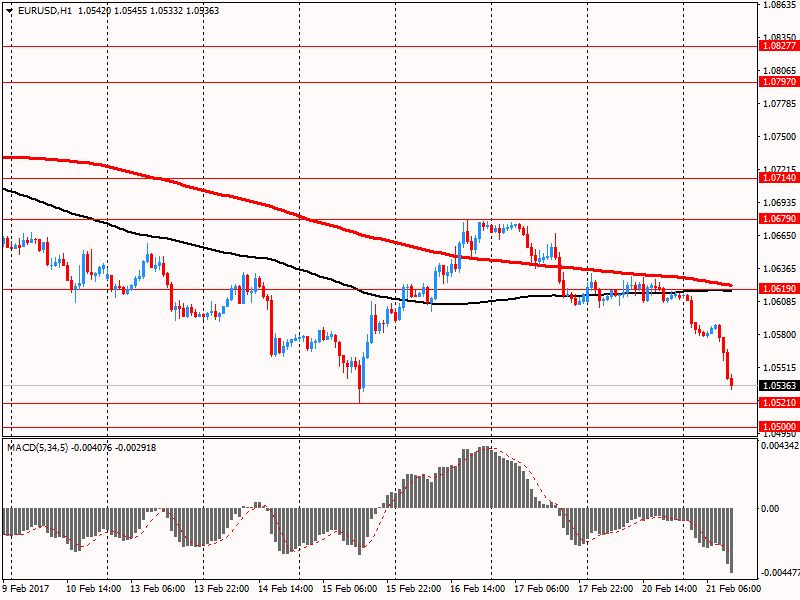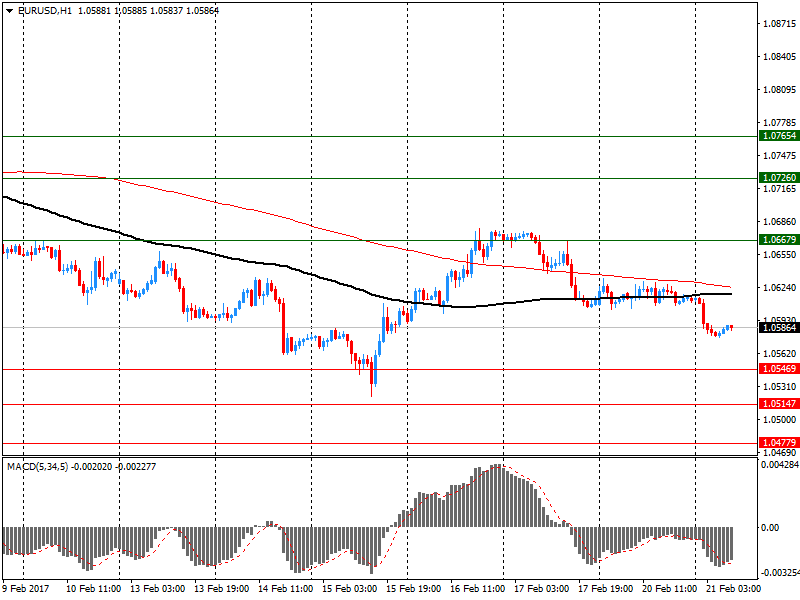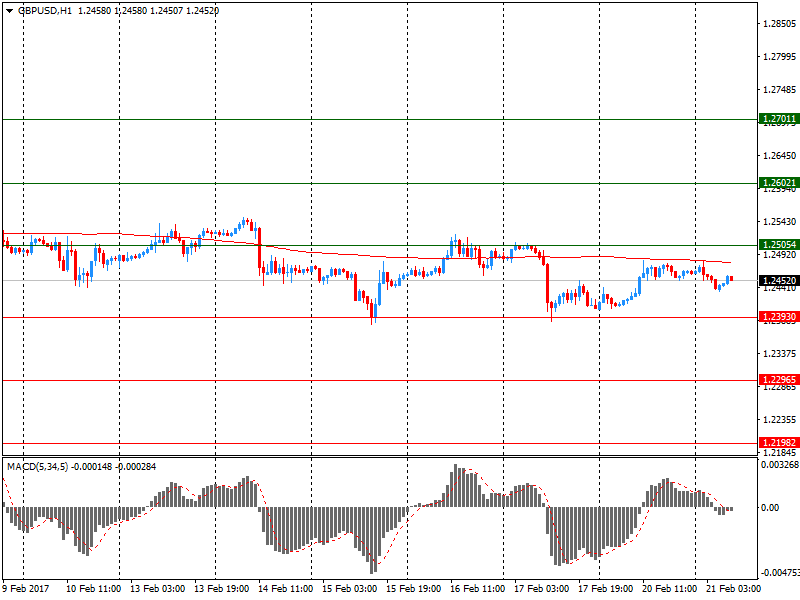Market news
-
23:30
Australia: Leading Index, January 0.0%
-
23:27
Currencies. Daily history for Feb 21’2017:
(pare/closed(GMT +2)/change, %)
EUR/USD $1,0535 -0,72%
GBP/USD $1,2473 +0,10%
USD/CHF Chf1,0094 +0,66%
USD/JPY Y113,66 +0,49%
EUR/JPY Y119,76 -0,22%
GBP/JPY Y141,78 +0,60%
AUD/USD $0,7673 -0,17%
NZD/USD $0,7159 -0,41%
USD/CAD C$1,3139 +0,27%
-
22:59
Schedule for today, Wednesday, Feb 22’2017 (GMT0)
00:30 Australia Construction Work Done Quarter IV -4.9% 0.3%
00:30 Australia Wage Price Index, q/q Quarter IV 0.4% 0.5%
00:30 Australia Wage Price Index, y/y Quarter IV 1.9% 1.9%
09:00 Germany IFO - Expectations February 103.2 103
09:00 Germany IFO - Business Climate February 109.8 109.6
09:00 Germany IFO - Current Assessment February 116.9 116.7
09:30 United Kingdom GDP, q/q (Revised) Quarter IV 0.6% 0.6%
09:30 United Kingdom GDP, y/y (Revised) Quarter IV 2.2% 2.2%
10:00 Eurozone Harmonized CPI January 0.5% -0.8%
10:00 Eurozone Harmonized CPI ex EFAT, Y/Y (Finally) January 0.9% 0.9%
10:00 Eurozone Harmonized CPI, Y/Y (Finally) January 1.1% 1.8%
11:00 United Kingdom BOE Deputy Governor for Financial Stability Jon Cunliffe speaks
13:30 Canada Retail Sales, m/m December 0.2% 0.1%
13:30 Canada Retail Sales YoY December 3%
13:30 Canada Retail Sales ex Autos, m/m December 0.1% 0.6%
14:00 Belgium Business Climate February 0.5 0.8
15:00 U.S. Existing Home Sales January 5.49 5.55
18:00 U.S. FOMC Member Jerome Powell Speaks
19:00 U.S. FOMC meeting minutes
20:00 United Kingdom MPC Member Shafik Speaks
-
15:47
U.S. President Trump preparing executive order to lift coal mining ban on federal lands - Washington Post - unnamed sources
-
15:31
Russia's trade ministry igned contract with Daimler to produce cars in russia starting from 2019
-
14:56
Weaker US business activity growth was mainly driven by slower momentum across the services sector - Markit
At 54.3 in February, the seasonally adjusted Markit Flash U.S. Composite PMI Output Index dropped from 55.8 in January but remained above the 50.0 no-change value for the twelfth consecutive month. The latest reading signalled that private sector output growth moderated from the 14-month high recorded at the start of 2017.
Weaker business activity growth was mainly driven by slower momentum across the service economy ('flash' index at 53.9, down from 55.6 in January). Manufacturing production continued to expand at a robust pace in February ('flash' output index: 55.7, down only slightly from 56.7 in January).
-
14:45
U.S.: Manufacturing PMI, February 54.3 (forecast 55.2)
-
14:45
U.S.: Services PMI, February 53.9 (forecast 55.7)
-
14:12
Change in GDT Price Index from previous event - 3.2%, average price $3,474. NZD/USD little changed
-
13:50
Option expiries for today's 10:00 ET NY cut
EUR/USD 1.0455-1.0470 (EUR 305 M) 1.0485-1.0500 (EUR 553 M) 1.0535-1.0550 (EUR 361 M) 1.0575-1.0585 (EUR 218 M) 1.0600 (EUR 1,187 M) 1.0610-1.0626 (EUR 809 M) 1.0635-1.0650 (EUR 598 M) 1.0694-1.0700 (EUR 296 M)
EUR/GBP 0.8425 (EUR 200 M)
USD/JPY 111.50 (USD 2,858 M) 113.15-113.30 (USD 516 M) 113.50 (USD 685 M) 114.35-114.45 (USD 314 M) 114.50-114.66 (USD 1,043 M) 114.95-115.06 (USD 430 M) 115.40-115.55 (USD 253 M)
EUR/JPY 118.00 (EUR 320 M) 120.50 (EUR 329 M)
AUD/USD 0.7659-0.7675 (AUD 393 M)
USD/CAD 1.2970-1.2975 (USD 482 M) 1.3040-1.3050 (USD 415 M) 1.3110-1.3125 (USD 195 M) 1.3300-1.3305 (USD 295 M)
-
13:12
U.S. Secretary of State Tillerson, Homeland Security Secretary Kelly to visit mexico feb 22-23 - State Dept
-
13:00
Orders
EUR/USD
Offers 1.0600 1.0620 1.0635 1.0650 1.0680 1.0700-05
Bids 1.0565 1.0550 1.0520 1.0500 1.0480-85 1.0450 1.0430 1.0400
GBP/USD
Offers 1.2450 1.2465 1.2480-85 1.2500 1.2520 1.2550
Bids 1.2415-20 1.2400 1.2380 1.2345-50 1.2330 1.2300
EUR/GBP
Offers 0.8520 0.8535 0.8550-55 0.8585 0.8600
Bids 0.8480-85 0.8450 0.8430 0.8400
EUR/JPY
Offers 120.30 120.50 120.80 121.00 121.35 121.50
Bids 119.75-80 119.50 119.00 118.80 118.50
USD/JPY
Offers 113.80-85 114.00-05114.20114.35 114.50
Bids 113.20 113.00 112.80 112.50 112.30 112.00
AUD/USD
Offers 0.7680 0.7700 0.7720 0.7735 0.7750
Bids 0.7620 0.7600 0.7580 0.7550
-
12:33
Anything less than 100% OPEC compliance not satisfactory - OPEC
-
11:21
Bank of England's Carney says for the last few years there has been some discomfort among mpc members that equilibrium unemployment rate estimate was too high - Inflation report hearings
-
BoE's Carney says UK households tend to look through economic uncertainty unless it leads to tighter financial conditions
-
BoE's Vlieghe says migration inflows do not necessarily affect amount of slack in UK labour market
-
BoE's Haldane says situation for consumers is about to change as their incomes are squeezed by higher prices, will throttle back consumption
-
Haldane says most consumers so far have looked through impact of referendum, perhaps that should not have been a surprise
-
Haldane says upward revisions to uk growth forecast reflect stimulus since referendum, unexpected consumer behaviour, stronger world economy
-
BoE's Mccafferty says would have preferred reduction in equilibrium unemployment rate estimate to 4.75 pct, not 4.5 pct
-
BoE's Mccafferty says skills shortages and level of vacancies suggest we are closer to full employment than weak wage growth suggests
-
-
11:14
EUR / USD has declined substantially approaching 15 February low, due to the imminent Fed rate hikes. Now the pair is trading at $ 1.0536, down 0.71%. The nearest support - $ 1.0521
Federal Reserve Bank of Philadelphia Governor Harker he signaled that at the March meeting, the central bank seems to support the rate increase, if there are additional signs that inflation is gaining momentum. According to the futures market, the likelihood of a Fed hike at the March meeting is 17,7% compared to 22,1% a day earlier.
-
10:25
IMF's Lipton says the decisive question is whether the U.S. pursues traditional multi-lateral paths to solve problems or opts for bilateral approach
-
09:35
UK public sector net borrowing decreased by £13.6 billion to £49.3 billion in the current financial year
Public sector net borrowing (excluding public sector banks) decreased by £13.6 billion to £49.3 billion in the current financial year-to-date (April 2016 to January 2017), compared with the same period in the previous financial year; this is the lowest year-to-date borrowing since the financial year-to-date ending January 2008.
Public sector net borrowing (excluding public sector banks) was in surplus by £9.4 billion in January 2017, a £0.3 billion larger surplus than in January 2016; this is the highest January surplus since 2000.
Public sector net debt (excluding public sector banks) was £1,682.8 billion at the end of January 2017, equivalent to 85.3% of gross domestic product (GDP); an increase of £91.7 billion (or 1.9 % points as a ratio of GDP) since January 2016.
-
09:30
United Kingdom: PSNB, bln, January 9.82 (forecast 14.4)
-
09:05
Highest reading for Euro Zone PMI since April 2011 - Markit
The pace of eurozone economic growth improved markedly to hit a near six-year high in February, according to PMI survey data. Job creation was the best seen for nine and a half years, order book growth picked up and business optimism moved higher, all boding well for the recovery to maintain strong momentum in coming months. Inflationary pressures meanwhile continued to intensify.
The Markit Eurozone PMI registered 56.0 in February, according to the preliminary 'flash' estimate (based on approximately 85% of final replies). Up from 54.4 in January, the latest reading was the highest since April 2011.
-
09:00
Eurozone: Manufacturing PMI, February 55.5 (forecast 55)
-
09:00
Eurozone: Services PMI, February 55.6 (forecast 53.7)
-
08:40
German private sector activity confirms the steady growth seen in Europe
German private sector output growth accelerated in February, as goods production expanded at the fastest rate in over three years and services activity rose solidly. The Markit Flash Germany Composite Output Index rose from January's fourmonth low of 54.8 to 56.1, the highest since April 2014 and signalling strong growth in the eurozone's largest economy. Output has risen continuously since May 2013.
Commenting on the flash PMI data, Trevor Balchin, Senior Economist at IHS Markit said: "The flash PMI results for February signalled the strongest growth of the German economy for just under three years, with manufacturing in particular expanding at a marked pace and services recovering the momentum lost at the start of the year. Moreover, the new Future Output Index is signalling strong confidence among firms, reaching a new high since its inception in mid-2012".
-
08:30
Germany: Services PMI, February 54.4 (forecast 53.6)
-
08:30
Germany: Manufacturing PMI, February 57.0 (forecast 56)
-
08:11
France PMI data highlighted an eighth successive month of growth - Markit
February's flash France PMI data highlighted an eighth successive month of growth in the French private sector. The Markit Flash France Composite Output Index, based on around 85% of normal monthly survey replies, registered 56.2, compared to January's reading of 54.1. The latest figure pointed to the sharpest rate of growth since May 2011.
-
08:09
In January 2017 French Consumer Prices Index declined by 0.2%
In January 2017, the Consumer Prices Index (CPI) declined by 0.2% over a month after an increase by 0.3% in December. Seasonally adjusted, it grew by 0.7%, after +0.1% in December. Year on year, the CPI accelerated sharply (+1.3% after +0.6%). Inflation has reached its highest level since November 2012.
Over one month, the fall was due to the seasonal decline in manufactured product prices, essentially those of clothing and footwear. However, this decrease was less strong than in January 2016, mainly because winter sales started later this year. The overall drop was mitigated by the sharp acceleration in energy prices and, to a lesser extent, in food prices.
-
08:00
France: Manufacturing PMI, February 52.3 (forecast 53.5)
-
08:00
France: Services PMI, February 56.7 (forecast 53.8)
-
07:28
We continue to see little benefit in owning EUR given good odds that political risks rise further in the next 2-3 month - Credit Suisse
"For all the talk of discord and chaos on the US political scene, this environment reminds us of the period around 2005-07 when commodities were strong, equity markets lacked volatility while making new highs and all forms of carry and illiquidity were in favour, with exotic currencies all the rage, against a backdrop of slow but steady rises in US interest rates. Of course, that particular era did not end well given the financial crisis came hard and fast in 2008. Also, these "feel-good vibes" have only existed in earnest since November, so the jury on longevity is still out.
Nonetheless some striking parallels exist with that bygone era, which for older market participants likely stand out as among the best of times.
Still, there are obvious differences too. For example EURUSD rallied at an annualized rate of about 15% between Q1 2006 and Q1 2008, taking the pair to all-time highs near 1.60.
With the pair now close to parity again, EUR remains hampered by negative rates, quantitative easing, macro divergences and political risks that are no longer infecting just the periphery but also true core countries like France.
We continue to see little benefit in owning EUR given good odds that political risks rise further in the next 2-3 month".
Copyright © 2017 Credit Suisse, eFXnews™
-
07:22
Swiss trade balance surplus higher than expected in January
In January 2017, exports rose by 5.3% (real: + 2.3%) on a working-day basis, thanks solely to the chemicals industry. Imports, on the other hand, fell by a total of 1.2% (real: - 6.8%). The company's balance sheet showed a surplus of CHF 4.7 billion, a new monthly peak.
-
07:16
Switzerland: Trade Balance, January 4.7 (forecast 3.03)
-
07:12
Options levels on tuesday, February 21, 2017
EUR/USD
Resistance levels (open interest**, contracts)
$1.0765 (4457)
$1.0726 (3008)
$1.0668 (3188)
Price at time of writing this review: $1.0586
Support levels (open interest**, contracts):
$1.0547 (5195)
$1.0515 (5522)
$1.0478 (6163)
Comments:
- Overall open interest on the CALL options with the expiration date March, 13 is 71025 contracts, with the maximum number of contracts with strike price $1,0800 (4872);
- Overall open interest on the PUT options with the expiration date March, 13 is 86412 contracts, with the maximum number of contracts with strike price $1,0500 (6163);
- The ratio of PUT/CALL was 1.22 versus 1.19 from the previous trading day according to data from February, 17
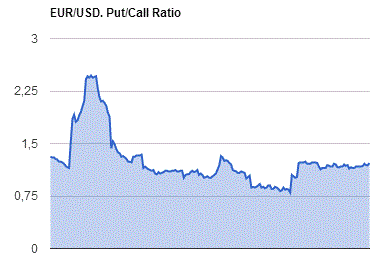
GBP/USD
Resistance levels (open interest**, contracts)
$1.2701 (2368)
$1.2602 (2279)
$1.2505 (2908)
Price at time of writing this review: $1.2452
Support levels (open interest**, contracts):
$1.2393 (1653)
$1.2296 (3253)
$1.2198 (1466)
Comments:
- Overall open interest on the CALL options with the expiration date March, 13 is 33671 contracts, with the maximum number of contracts with strike price $1,2800 (3028);
- Overall open interest on the PUT options with the expiration date March, 13 is 35955 contracts, with the maximum number of contracts with strike price $1,2300 (3253);
- The ratio of PUT/CALL was 1.07 versus 1.11 from the previous trading day according to data from February, 17
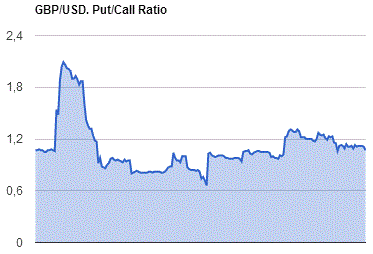
* - The Chicago Mercantile Exchange bulletin (CME) is used for the calculation.
** - Open interest takes into account the total number of option contracts that are open at the moment.
-
06:55
Flash Japan Manufacturing PMI at 35-month high - Markit
-
Flash Japan Manufacturing PMI at 35-month high of 53.5 in February (52.7 in January).
-
Flash Manufacturing Output Index at 54.3 (53.2 in January).
-
Sharpest rate of growth for three years. Record-high business confidence at Japanese manufacturers.
Commenting on the Japanese Manufacturing PMI survey data, Samuel Agass, economist at IHS Markit, which compiles the survey, said: "Japan's manufacturing engine shifted into a higher gear during February, as faster increases in output, new business and employment were reported. Subsequently, business confidence was at a survey-high, with goods producers buoyed by the strongest upturn in the sector for 35 months".
-
-
06:53
Fed’s Harker: Won’t Take March Hike Off Of The Table - MNI
-
06:50
RBA meeting minutes: weaker than expected GDP, reflecting some temporary factors
"Members commenced their discussion by noting that the data on activity and inflation in the global economy had been more positive over recent months. There had been a broad-based pick-up in surveyed conditions in manufacturing across economies as well as in growth in industrial production and merchandise trade. GDP growth in Australia's major trading partners had increased a little over recent quarters and forecasts for 2017 and 2018 had been revised a little higher, partly because of expectations of expansionary fiscal policy in the United States. However, trading partner growth was still expected to ease slightly towards the end of the forecast period, reflecting a projected slowing in growth in China in the medium term.
Members observed that inflation in the advanced economies had continued to increase recently, mainly as a result of higher oil prices. Some measures of inflation expectations had also risen in late 2016. These developments and a decline in spare capacity were expected to flow through to higher core inflation in the advanced economies over time. Inflation rates were still below central banks' targets in most countries.
Members started their discussion of the domestic economy by noting the outcome for GDP growth in the September quarter. The 0.5 per cent decline in real GDP in the quarter was considerably weaker than had been expected, reflecting some temporary factors, including disruptions to coal supply and bad weather. Slower growth in consumption had also been a factor. This weakness was not expected to have continued into the December quarter and the forecasts for quarterly GDP growth were little changed. GDP growth was expected to pick up to around 3 per cent in year-ended terms later in 2017, and to remain above estimates of potential growth over the rest of the forecast period".
-
04:31
Japan: All Industry Activity Index, m/m, December -0.3% (forecast -0.2%)
-
00:30
Japan: Manufacturing PMI, February 53.5
-
